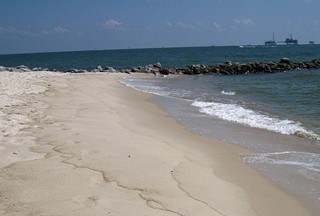A team of scientists working in the Gulf of Mexico have found that contaminants from the 2010 Deepwater Horizon Spill were transported by phytoplankton and associated materials from the ocean surface to the seafloor, according to a Florida State University oceanographer.
In a study published this week in the Proceedings of the National Academy of Sciences, researchers, including FSU Professor of Oceanography Jeff Chanton, lay out their findings that contaminants released during the spill combined with a bloom of phytoplankton to create what has been called a “dirty blizzard.” That blizzard then sank to sea floor and essentially stayed put.
“It’s kind of like a long-term reservoir,” Chanton said. “The oil is more likely to be preserved there.”
In some ways, that is good, Chanton said, because it’s not floating on the surface where it can be scooped up by pelicans, surface fish and other creatures. But, if disrupted, these seafloor toxins could easily be released and enter the food web and also affect life on the seafloor, such as deep water coral.
Phytoplankton are the self-feeding components of the plankton community, and are typically too small to be seen by the naked eye.
“The research is showing us that even though it disappeared from the surface, it was present in the water column for months,” said Beizhan Yan, an environmental chemist from the Lamont-Doherty Earth Observatory at Columbia University and the lead author on the study. “That is sort of an interesting point. We never knew how long it was staying in the water column.”
For the current study, researchers began setting sediment traps shortly after the well had been capped in 2010. It gave researchers a type of time-lapse capture of how the oil and phytoplankton combined and then sank to the Gulf floor.
The researchers found that the movement of the oil and other contaminants to the seafloor was intensified during August and September 2010 by an abnormally large bloom of phytoplankton. Chanton and Yan do not know if the bloom was caused by the oil spill or some other natural process.
Co-authour Uta Passow of University of California, Santa Barbara investigated the production by phytoplankton of a material that acts almost as an adhesive or glue for other materials in the water. As these materials combined, they created what scientists have called marine oil snow sedimentation and flocculent accumulation. They also refer to it as a dirty blizzard.
The findings are part of ongoing efforts by scientists to detail the long-term ecological effects of the 2010 oil spill, which leaked as much as 200 million gallons of crude oil into the Gulf of Mexico. It was the largest marine oil spill in U.S. history. Some of the oil was recovered, evaporated or burned at the surface. But some was totally unaccounted for in the cleanup efforts.
It seemed to have totally disappeared.
In 2015, Chanton estimated that anywhere from 6 million to 10 million gallons of crude oil had settled at the bottom of the Gulf of Mexico.
Researchers hope to follow up this work with additional studies on how the environment of the Gulf of Mexico has changed since the spill and the overall ecological impact of the disaster.
Other authors on the paper are Dorothy Pak and Julia Sweet from the UC, Santa Barbara; Vernon Asper and Arne Diercks from the University of Southern Mississippi; and Masha Pitiranggon of Columbia University.
The research is funded by the Gulf of Mexico Research Initiative through the ECOGIG consortium. Funding was also provided by the National Institute of Environmental Health Sciences Center for Environmental Health.


